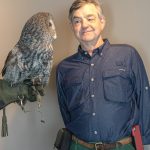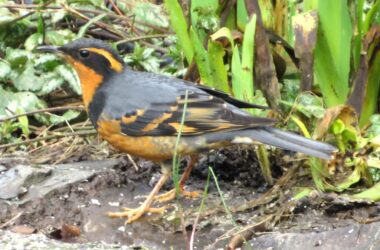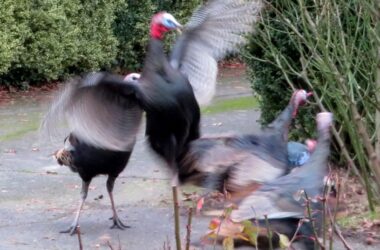There are three chickadee species here year-round in Oregon. Two are found in the Willamette Valley. These are the black-capped and chestnut-backed.
Chickadees do not like habitat without trees. They can deal with open forest, but you will not see them in the middle of an open grassland perched next to a meadowlark. Most species in their family are on the Northern Hemisphere though some live in tropical Africa.
The black-capped is widespread across North America, mostly south of the Arctic
and well north of the Gulf Coast and Mexican border. In California it is found only north of Eureka. The chestnut-backed is found primarily along the Pacific Coast from Alaska south to Monterey, California. It does range east to northern Idaho.
The black-caps prefer deciduous trees. In our area that often means cottonwood, maple, oak, willow. The slightly smaller chestnut-backed tends to be near or in conifers. A forest within their range that has redwoods, Doug-fir, spruce or pine will have chestnut-backs at low and modest elevation.
That brings us to the third species: mountain chickadee, same size as the black-caps. It usually inhabits conifer or aspen forest, and ranges as far east as the Rockies. It ranges north-south from New Mexico to the Yukon. Here in Oregon, lodgepole pine forests seem to be especially good for this species. It may drop below 4000 feet elevation in winter. This chickadee is the only one in America with a white eyebrow.

The “big” chickadees are 5.25 inches long. Each bird weighs less than half an ounce. They are energetic, often in family groups or small flocks—moving and foraging. Wintering birds often follow the local chickadees around because the locals know where to eat. Chickadees eat insects and spiders and their eggs, seeds and fruit. They will cache food as well. If you have feeders they will take seeds and suet.
In winter chickadees have high nightly energetic demands, due to their small size and the subfreezing winter temperatures. Each bird needs an adequate energy reserve. The fat stores of chickadees on midwinter evenings provide slightly more energy then expended overnight. That’s based on laboratory results. The chickadee lowers its energy use overnight. They lower nocturnal body temperature around 20 degrees below normal daytime body temperature (107 degrees Fahrenheit). When exposed to 32 degrees overnight, chickadees can reduce their hourly metabolic expenditure almost one-fourth.
Our locals will be nesting soon—they use cavities and nest boxes with small openings.
The name? In Britain they call the European species “tits.” Here we use their call to name them. From a tree you will hear one singing “chick-a-dee-dee-dee.”
Read a scientific report on chickadees on winter nights: https://link.springer.com/article/10.1007/BF00695350
For information about upcoming Salem Audubon programs and activities, see www.salemaudubon.org, or Salem Audubon’s Facebook page.
Harry Fuller is an Oregon birder and natural history author of “Freeway Birding” and the newly-published “Birding Harney County.” He is a member of the Salem Audubon Society. Contact him at [email protected] or atowhee.blog. His “Some Fascinating Things About Birds” column appears regularly in Salem Reporter.
SUPPORT OUR WORK – We depend on subscribers for resources to report on Salem with care and depth, fairness and accuracy. Subscribe today to get our daily newsletters and more. Click I want to subscribe!

Harry Fuller is an Oregon birder and natural history author of three books: “Freeway Birding,” "Great Gray Owls of California, Oregon and Washington," and "San Francisco's Natural History--Sand Dunes to Streetcars." He leads birding trips for the Malheur Field Station. He is a member of the Salem Audubon Society, and leads bird trips locally. Harry has just published a new book, BIrding Harney County.









